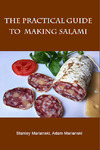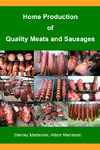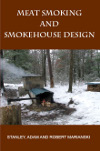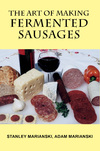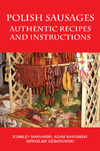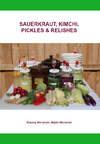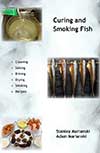Meats and Sausages
Spreadable Fermented Sausages
Reprinted with permission from the book The Practical Guide to Making Salami
Eating fresh ground beef was an accepted custom in Europe, and "steak tartare" can still be found on the menu in every European country. In the late 19th century, the Hamburg steak became popular on the menus of many restaurants in the port of New York. This kind of fillet was beef minced by hand, lightly salted, and often smoked, and it was usually served raw in a dish along with onions and bread crumbs. Cannibal sandwiches (fresh ground beef) are a longtime Milwaukee tradition in Wisconsin.
Health concerns have reduced the popularity of this meat dish in some parts of the world because of the danger of contamination by bacteria and parasites. In the United States, ground beef is not typically sold with the expectation that it will be eaten uncooked. According to the World Health Organization, when basic hygienic rules are followed, and fresh meat is used, the risk of bacterial infection is low. The best quality salami were never cooked, fermented, or acidified; hence technically speaking, they were raw meat. However, the meat was made safe for consumption by treating it with salt and nitrite and prolonged drying.
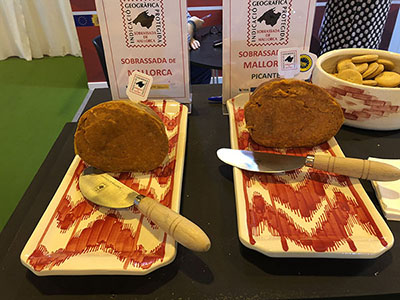
Spanish Sobrassada de Mallorca holds a prestigious European Certificate of Origin.
Spreadable sausages are finely ground, incorporate soft fat, and have a moderate pH drop. Since spreadable sausages are neither cooked nor strongly fermented/acidified or dried, they need to be refrigerated as their shelf life is short, as opposed to salami, which can last a year at room temperature. Thus, unlike raw ground beef steaks or sandwiches, which need to be immediately consumed, spreadable sausages can last one week in the refrigerator, although they are not cooked. They can be classified as non-heated semi-dry sausages; what separates them from other fermented products is their spreadability, soft texture, and original "meaty" taste. Spreadable fermented sausages are popular in Germany (Mettwurst, Teewurst), Poland (Metka); and in the areas of the USA where immigrants from those countries have settled in the past. These sausages are spreadable like liverwurst, however, they are made from fermented meat that is often smoked, but not submitted to cooking. German and Polish spreadable sausages are usually smoked. In Southern Europe, there is a well-known Italian spreadable Nduja and very popular Spanish sobrasada sausages, the best known, of course, the Sobrassada di Mallorca which holds a prestigious European Certificate of Origin.
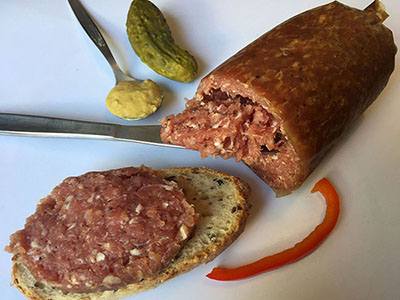
Polish Metka spreadable sausage.
General Guidelines
To retain their soft texture and meaty taste, spreadable sausages must:
- Be slightly fermented so there is a small pH drop, resulting in slight acidity and almost no tangy taste. As pH lowers, the sausage texture becomes firmer, decreasing its spreadability. The less acidity sausage has, the easier it is to spread.
- Have a unique, slightly sour taste and flavor which people like. Rapid fermentation to low pH must not be allowed as it promotes drying, hardens the texture, and creates a sour taste. < li>Should not have low Aw as drying/removal of moisture will harden their texture, and the moisture is needed to make the sausage soft and spreadable.
The pH drop should fit into the 5.1-5.4 range. Lower pH will harden the texture and make the sausage less spreadable. Acidity is obtained by adding dextrose, sucrose, or lactose, starter cultures and a proper choice of fermenting temperature. The sausages are generally subjected only to one or two-day fermentation at 68-77° F (20-25° C), which is sufficient for curing color formation, but does not guarantee microbiological safety. Neither acidity, nor the amount of moisture is sufficient to make them shelf-stable, and since they are not heated, they must be kept in a refrigerator.
The best quality spreadable sausages are naturally fermented, usually with starter cultures. Acidulants such as Gdl or citric acid should be avoided, as they increase the firmness of the texture, which will negatively affect the spreadability. In addition, they develop a sour taste, which might not be accepted by a customer.
All steps prior to meat stuffing are extremely important, given that they affect the microbiological safety of the meat. The meat must be fresh or properly de-thawed, equipment and work tables should be sanitized, and the manufacturing must be performed at the lowest possible temperature. Complying with those rules will slow down the growth of spoilage bacteria and protect the meat from being infected with bacteria residing on the premises.
Adding salt and sugar will lower Aw by about 0.2 units, nitrite will inhibit the growth of pathogenic bacteria, and 10 million starter culture bacteria will compete with spoilage bacteria for oxygen and nutrients. The sausages can be stuffed into permeable synthetic casings such as collagen or cellulose to allow smoke penetration and some removal of moisture. Both processes are relatively short, so weight loss is almost negligible.
Manufacturing Process
Selection of Materials
Most spreadable fermented sausages are made of pork, but other fatty meats like beef or lamb may be used. A combination of beef and pork fat is also popular. Pork must be trichinae-free. If in doubt, freeze pork before processing as the official regulations prescribe (see the Note at the bottom of the page). The texture of spreadable sausages must be soft and moist to be spreadable over a slice of bread. This requires a relatively large amount of soft fat (40-50%), such as belly fat, dewlap, and jowls; however, finely minced back fat is often used. Both fat and meat are finely minced, which adds not only to a better spreadability but also covers lean meat particles with a thin oil film that retards the removal of moisture, preserving the softness of the sausage. When not enough soft fat is available, about 1-2% vegetable oil may be added; however, take into account the amount of intramuscular fat the meat contains. Vegetable oil offers two benefits:
- Oil is transparent so the sausage seems to be leaner.
- Oil is less prone to rancidity.
Grinding
Spreadable sausages can also be grouped by the size of minced particles:
- Fine (Teewurst) - cuts of cold meat and fat are mixed with all ingredients and then ground through a 2-3 mm (1/16 - 1/8") plate and fermented at 95% humidity.
- Medium coarse (Mettwurst) - cuts of meat and fat are partially frozen, mixed with all ingredients, ground through a 3 - 8 mm (1/8 - 5/16") plate, and fermented at 95% humidity.
Commercially produced spreadable sausages like Teewurst can be chopped in a bowl cutter to 1/16" (1.5 - 2 mm) size, but at home, using a 1/8" (3 mm) grinder plate is fine, providing that partially frozen meat and frozen fat are processed.
Mixing
Mix meat, fat, and all the ingredients together. If acidulant is added, proceed to stuffing without a delay.
Stuffing
Eliminate the introduction of air during stuffing as much as possible. Use permeable casings as most sausages are smoked and occasionally briefly dried. To shorten the process, using Gdl at 2% (2 g/1 kg of meat), sugar (3 g/kg), and fast fermented culture brings also a satisfying result. If no culture is added, use Gdl at <0.5% (5 g/kg), no sugar is necessary. However, adding slow-fermenting carbohydrates such as maltose, lactose, honey or flavorings will offset some of the tangy taste.
Gdl (if used) drops pH fast; however, it contributes to a harder texture, a feature that is not desired in spreadable sausages. Gdl should be applied below 5 g/ kg, otherwise, the taste will be too sour and metallic, especially when sugar is also added. Potassium nitrate alone or in Cure #2 should not be used as the production cycle is short and curing bacteria will not have time to force nitrate into creating nitrite. Given that adding Gdl to minced meat immediately hardens its texture, the mixture should be stuffed without delay.
Fermentation
- 1 day, 64° F/18° C, 80% humidity. Resting/fermenting, little airflow.
- 1 day, 72° F/22° C, 90% humidity. Fermentation.
- 1 day, 72° F/22° C, 85% humidity. Fermentation.
- 12 hours, 71° F/22° C, 80% humidity. Smoking/Drying.
- Salt 2.5%, Cure #1: 2.5 g - Take into account that Cure #1 contains 93.75% salt. Dextrose 0.3%. T-SPX culture. A weak airspeed is introduced, and a thin, cold smoke is applied. For large diameter casings add another day of smoking/drying.
Smoking
After fermentation, the sausages are smoked with a thin cold smoke at 64-72º F (18-22º C), 80% humidity. The surface of sausages must be dry before smoke is applied.
- Mettwurst and Teewurst - smoked for about 12 hours and refrigerated.
- Italian Nduja - smoked and dried.
- Spanish Sobrassada is not smoked after fermentation but only dried for about 34-45 days.
The process of making spreadable sausages ends with the cold-smoking stage. Since they are neither sufficiently fried nor cooked, they last for 3-5 days and must be stored in the refrigerator or kept at cool temperatures.
Note: when Gdl has been added, the sausage can be dried at 68º F (20º C), 90% humidity, and moderate airflow for one day. Then, it can be cold smoked. For large-diameter casings, add another day of smoking/drying.
Drying
Spreadable sausages are often shortly dried during fermentation/smoking steps. An overly dried sausage will be too hard to spread. Spreadable sausages only need a little drying as they are not expected to have a very long shelf life. A very weak airspeed is introduced, about 0.1 m/sec.
Note: if spreadable sausage is allowed to dry at 53-57º F (12-14º C), it will become, in time a semi-dry sausage.
Emulsifiers
These two ingredients are often added as they contribute positively to better spreadability:
Guar gum has almost eight times the water-thickening potency of cornstarch, and only a very small quantity is needed to produce sufficient viscosity. Guar gum can bind and prevent the removal of some water, which will greatly extend the spreadability of the sausage.
Mustard flour is produced by grinding the seed of the white mustard plant to a fine powder. It is used in many foods, including meat, chicken, fish, vegetables, and Asian cooking. Adding mustard flour does not change the flavor of the sausage, however, it slows down the action of lactic acid bacteria, which leads to a softer texture. In addition, mustard flour retards fat rancidity. It binds water well and is often added to spreadable sausages at a 1-1.5 ratio to extend spreadability.
Storage
The shelf life of spreadable sausages is much shorter than that of dry or semi-dry fermented sausages, which is why American supermarkets do not stock them. Secondly, they are not cooked, so it will be hard for commercial producers to satisfy the requirements of the official standards. However, their unique texture and flavor are popular in Germany and Poland. These sausages are produced by neighborhood butchers who cater to the local clientele.
Safety
Note Uncooked pork and wild game meat can be infected with Trichinella spiralis worm. The disease is almost non-existent in American pork due to their strictly controlled feed, but free-roaming pigs on farms can be at risk. The parasite is easily killed by heating meat to 145º F (63º C) or by freezing. Pork meat cannot be heated when making spreadable sausages, given that they will lose their texture, flavor, and character. However, pork meat can be treated for trichinae by freezing as recommended by the United States Department of Agriculture: Treatment of Pork to Destroy Trichinae.

